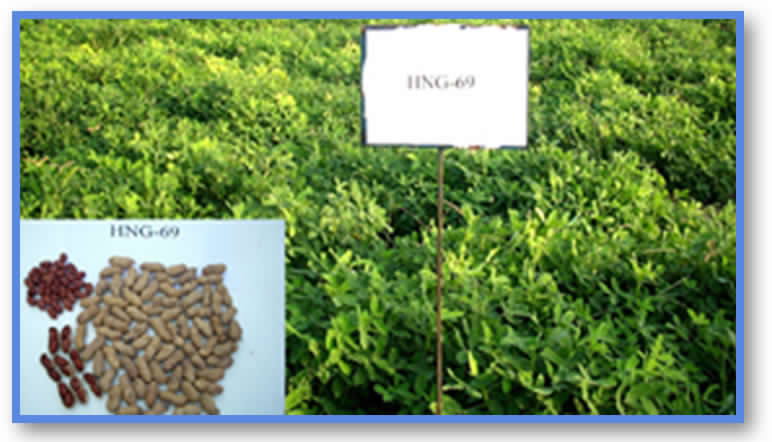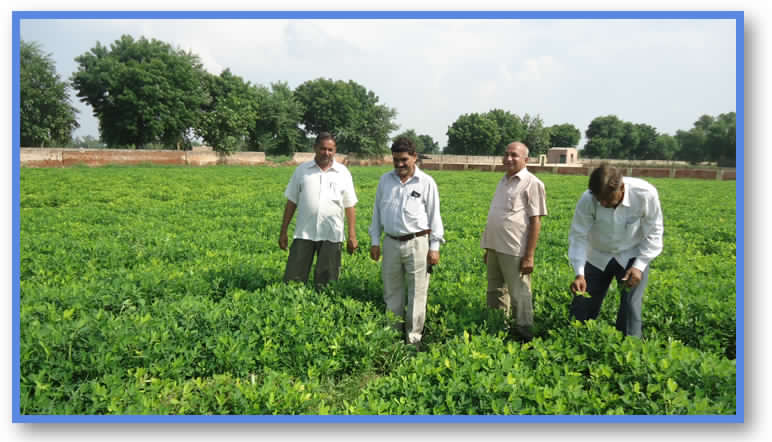
Swami Keshwanand Rajasthan Agricultural University, Bikaner
स्वामी केशवानन्द राजस्थान कृषि विश्वविद्यालय, बीकानेर
Quick Links
Quick Links
ARSS Hanumangarh

- Location : Hanumangarh Town
- Area of the Farm : 56 ha. (50.0 cultivable)
- Source of Irrigation : Canal,Tube-well and a Water tank (50 lakh litres)
1. Brief history/ basic information of centre
Hanumangarh district was carved out from Sriganganagar district and formally created on 12th day of July, 1994 as 31st district of Rajasthan state, is situated at 29° 5′ to 30° 6′ North and 74°3′ to 75º 3′ East, shares its boundaries with Haryana state in East, Sriganganagar district in the West, Punjab state in the North and Churu district in the South. The geographical area of the district is 9656.09 Sq. Km. The climate of the district is semi-dry, extremely hot during the summer and extremely cold during winter.
The maximum average temperature remains 18° to 48° and minimum average is 2° to 28° celcius. The average rainfall during the year is 225 to 300 mm.
This centre was started from September, 1976 with the merger of Govt. research in university as the Model Agronomy system and the name of Model Agronomy system was changed as Cropping Research system. AICRP on Groundnut was started in 1987.

2. Projects at ARSS, Hanumangarh:

-
- AICRP on Groundnut since 1987 and now the project has been shifted from Hanumangarh to ARS,
Bikaner with effect from 01-04-2015 in 12th plan. At present this centre is working as varification
centre for groundnut research.
- AICRP on Groundnut since 1987 and now the project has been shifted from Hanumangarh to ARS,
-
- ICAR project on Arid Legume: The centre is conducting Guar Breeding, Agronomy and Guar
Pathology experiments.
- ICAR project on Arid Legume: The centre is conducting Guar Breeding, Agronomy and Guar
-
- Seed Multiplication Farm (Non-Plan)
- Station and AICRP trials on Sesame.
3. Staff Position
-
- Dr. Data Ram Kumhar, Professor (Pl. Pathology) working as Officer Incharge and Project Incharge of Arid Legume.
- Two Agricultural Supervisors and one LDC are deputed at Hanumangarh from Bikaner and Sri Ganganagar for Research and farm work, one Tractor Driver and one Ploughman is working in Non –plan.

4. Crop Improvement in Groundnut :

Major Objectives:
To cater to the need of Zone-I of country comprising Rajasthan, Uttar Pradesh, Punjab and
Haryana, Hanumangarh centre has been working with following main objectives –
- To breed for high yielding varieties
- To breed for HPS grade / confectionery varieties
- To develop package of practices for management of groundnut diseases.
A Virginia Bunch variety HNG-10 with high shelling turnover : 70% and average pod yield of 2000 to 2500 kg /ha was the first variety released and notified for Zone-I of country comprising Rajasthan, Punjab, Haryana and Uttar Pradesh under AICRP-G system in 1999 by this centre.
Virginia Bunch (Semi-spreading ) ICHG-00440 (Mallika) with large pods is a new confectionery groundnut variety , being the first Large seeded variety identified for release at All India Level and notified on 27th August 2009. ICHG-00440 has large uniform seed size which is suitable for export.
A new Virginia Bunch high yielding ( 2800 to 3000 kg /ha) groundnut variety HNG-69 has been released and notified on 29th Jan,2010 having 100 kernel weight – 50gm, 2 Seeded Pods with tan color kernels.
A new Virginia Bunch high yielding (mean pod yield of 2648 kg/ha) groundnut variety HNG-123 with Salmon colored Kernels and high Shelling turnover , marker for certification has been released and notified in year 2011.
Varieties developed and Released at State level :
TBG-39 (2006)
- A Virginia Bunch Groundnut variety TBG-39 (Trombay Bikaner Groundnut-39) was released as bold seeded & high yielding variety at State level having 100 kernel weight – 66.8 gm with average pod yield of 2500-3000 kg/ha.

5. Crop Production :
A new Virginia Bunch high yielding (mean pod yield of 2648 kg/ha) groundnut variety HNG-123 with Salmon colored Kernels and high Shelling turnover , marker for certification has been released and notified in year 2011.
6. Crop Protection :
Recommendations added in Package Of Practices for Zone I B of Rajasthan
- S.T. with T.harzianum @10g/kg seed in combination with soil application of T. harzianum @ 4.0 kg/ha
(added in 50 kg FYM, 15 days prior to its application) was effective for management of collar rot of
Groundnut. - Seed treatment with G.virens @10g/kg seed in combination with soil application of G. virens @10 kg/ha
(added in 200 kg FYM, 15 days prior to its application & kept in shade) was effective for management
of collar rot and root rot of groundnut. - Recommendations developed for management of Aflatoxin in groundnut.
- Seed treatment with Tubeconazole 2DS @ 1.5 gm/kg and/or Carboxin (37.5%) +Thiram (37.5 %) @
2.0g/ kg seed was effective for management of collar rot of groundnut. - Seed treatment with Propiconazole 25 EC @ 2.0 ml/kg was effective for management of collar rot of
groundnut. - ST with T.harzianum @10g/kg seed+Soil application of Trichoderma harzianum @ 4 kg/ha +Soil
application of Castor cake @ 250kg/ha for management of Collar rot of groundnut and foliar
Spray of Hexaconazole @ 1.0ml/lt at the initiation of Tikka disease and IInd spray after 15 days of Ist
spray for control of Tikka disease of groundnut and also recommendaded at National level. - IPM module for disease and pest management of groundnut : Seed treatment with T. harzianum
@10g/kg seed+ Soil application of T.harzianum @ 4 kg/ha + Soil application of Neem cake @
250kg/ha for management of Collar rot of groundnut and foliar spray of Mancozeb @ 2.0g/lt at the
initiation of Tikka disease. - Soil drenching of Hexaconazole 5 EC @1.5 ml/litre and/or Propiconazole 25 EC @ 1.5 ml/litre at the
time of disease initiation were efeective for management of collar rot of groundnut in standing crop. - Organic model for management of Collar rot and leaf spot disease of groundnut : ST with
T.viride @10g/kg seed+Soil application of T.viride @ 4 kg/ha +foliar Spray of Neem seed kernel
extract @ 5.0% at 45 and 60 DAS - S.T. with Carbendazim @ 2.0 gm/kg seed + soil application of T.viride in 100 kg FYM/ha were
effective for management of root rot complex in Clusterbean. - Application of Imazethapyr +Imazamox @ 40 g a.i./ ha at 20 days after sowing in guar crop was
found effective for weed control and higher productivity in Guar crop and this recommendation
was added in National level.
7. Breeder seed production :
Hanumangarh is a very potential centre. It has 56.0 ha. Land, out of which 50.0 ha. land is cultivable with canal water. This cenre is producing TFL, Nucleus and Breeder seed of different varieties. This centre take up the Breeder seed of different varities of Groundnut, Moong and Guar in kharif and Gram, Wheat and Barley in Rabi . This centre fulfill the breeder seed requirement at National and state level.
8. Resource generation: :
Income is generated in revolving fund from sale of breeder seed of kharif and Rabi crops. Annual income of revolving fund in year 2004-05 was Rs. 3,45,368 and now it reached upto Rs. 27,16,415 in year 2014-15 and this income is utilized for resource generation and development of farm infrastructure.
Director
Office E-mail Address : arsshng@gmail.com
Office Phone No. : 01552-222935
